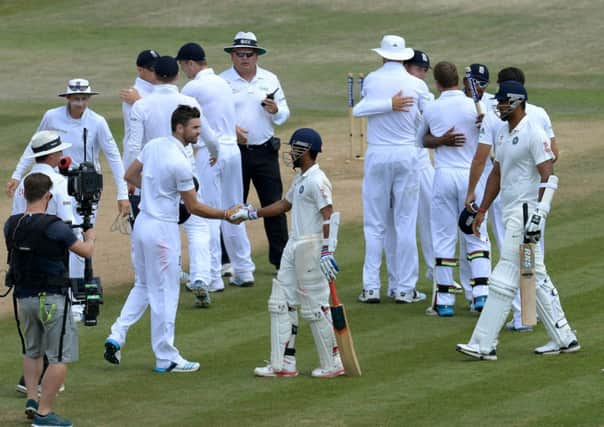Chris Waters: Handing referrals to third umpires may break the impasse


In other words, imagine if technology was used in every game apart from those involving Jose Mourinho’s men.
Yet that is precisely the un-level playing field that exists in international cricket when it comes to using DRS, the Decision Review System by which umpiring decisions are challenged and either ratified or overturned.
Advertisement
Hide AdAdvertisement
Hide AdEvery country employs DRS apart from India, who refuse to budge from their stubborn position.
Prior to the current Test series between England and India, the England and Wales Cricket Board asked their Indian counterparts to soften their stance.
The answer they got was “no way, Jose”, or words to that effect.
Consequently, we have watched howler after howler go uncorrected – not least the two that affected Yorkshire batsman Gary Ballance in this week’s third Test at Southampton.
Advertisement
Hide AdAdvertisement
Hide AdBallance was “sawn off” in the first innings when he was given out caught behind to a ball that went several inches past his bat, and he was “sawn off” in the second when he was adjudged caught at short leg from a delivery that bounced off his pad, his phlegmatic reaction to both verdicts somewhat more impressive than the verdicts themselves.
India, of course, have a long-standing distrust of DRS, a wariness that dates back to 2008, when they took part in the first series in which it was used in Sri Lanka.
India were successful with just one of their 20 referrals in that series, which did not go down well with the likes of Sachin Tendulkar et al.
But the DRS technology has improved, and it was thought that Tendulkar’s retirement might lead to a change of heart by the Board of Control for Cricket in India, with the master batsman thought to have been one of the strongest opponents to its introduction.
Advertisement
Hide AdAdvertisement
Hide AdAlthough there are hopes that India might back down sooner rather than later, the fact that they have been allowed to stand alone for so long highlights the International Cricket Council’s inability to govern the game and the fact that India effectively run the sport.
A compromise solution seems the likeliest way forward.
There appears some mood within the BCCI to put responsibility for referrals solely in the hands of the third umpire rather than the players.
This would cut out the tactical reviews that slow down the game and focus more on eliminating so-called howlers.
Adopting this policy would at least allow the BCCI to save face and be seen to be driving the debate, although it would clearly place much greater emphasis on the third umpires and how they are trained to deal with such incidents.
Advertisement
Hide AdAdvertisement
Hide AdThe issue now is not whether DRS is used – sadly, we have gone too far down the road to turn back, even though some of us (myself included) thought it was a bad idea in the first place and warned that it would open the proverbial can of worms and undermine umpires.
Rather, it is ensuring consistency across the board.
How strange it was to see Ballance given out to two decisions that would have been instantly overturned on review.
India have a duty to ensure such inconsistencies do not persist.